Growth Optimisation and Kinetic Profiling of Diesel Biodegradation by a Cold-Adapted Microbial Consortium Isolated from Trinity Peninsula, Antarctica
Abstract
Simple Summary
Abstract
1. Introduction
2. Materials and Methods
2.1. Sampling and Storage
2.2. Microbial Culture Medium
2.3. Consortium Isolation and Screening
2.4. Evaluation of Microbial Growth and Diesel Biodegradation
2.5. Optimisation Using One-Factor-At-A-Time (OFAT) Approach
2.6. Optimisation Using Response-Surface Methodology (RSM) Statistical Approach
Model Validation
2.7. Kinetics of Modelling Consortium BS24 Growth in Diesel Medium
Statistical Analyses for Kinetics Modelling
3. Results
3.1. Consortium Isolation and Screening
3.2. Soil BS24 Characterisation
3.3. Optimisation of Growth Medium Using OFAT Approach
3.4. Optimisation of Growth Using RSM Approach
3.5. Growth Kinetic Modelling
4. Discussion
5. Conclusions
Supplementary Materials
Author Contributions
Funding
Institutional Review Board Statement
Informed Consent Statement
Data Availability Statement
Acknowledgments
Conflicts of Interest
References
- Yao, Y.; Meng, X.-Z.; Wu, C.-C.; Bao, L.-J.; Wang, F.; Wu, F.-C.; Zeng, E.Y. Tracking human footprints in Antarctica through passive sampling of polycyclic aromatic hydrocarbons in inland lakes. Environ. Pollut. 2016, 213, 412–419. [Google Scholar] [CrossRef] [PubMed]
- IAATO. IAATO overview of Antarctic tourism: 2018–19 season and preliminary estimates for 2019–20 Season. Information Paper 140. In Proceedings of the Antarctic Treaty Consultative Meeting XLII, Prague, Czech Republic, 27–28 June 2019. [Google Scholar]
- Subramaniam, K.; Ahmad, S.A.; Shaharuddin, N.A. Mini review on phenol biodegradation in Antarctica using native microorganisms. Asia Pac. J. Mol. Biol. Biotechnol. 2020, 28, 77–89. [Google Scholar] [CrossRef]
- Tin, T.; Fleming, Z.; Hughes, K.A.; Ainley, D.; Convey, P.; Moreno, C.; Pfeiffer, S.; Scott, J.; Snape, I. Impacts of local human activities on the Antarctic environment: A review. Antarct. Sci. 2009, 21, 3–33. [Google Scholar] [CrossRef]
- Cripps, G.C.; Shears, J. The fate in the marine environment of a minor diesel fuel spill from Antarctic research station. Environ. Monit. Assess. 1997, 46, 221–232. [Google Scholar] [CrossRef]
- De Jesus, H.E.; Peixoto, R.S. Bioremediation in Antarctic Soils. J. Pet. Environ. Biotechnol. 2015, 6, 248. [Google Scholar] [CrossRef]
- Balmer, J.E.; Hung, H.; Yu, Y.; Letcher, R.J.; Muir, D.C.G. Sources and environmental fate of pyrogenic polycyclic aromatic hydrocarbons (PAHs) in the Arctic. Emerg. Contam. 2019, 5, 128–142. [Google Scholar] [CrossRef]
- McWatters, R.S.; Rowe, R.K.; Wilkins, D.; Spedding, T.; Hince, G.; Richardson, J.; Snape, I. Modelling of vapour intrusion into a building impacted by a fuel spill in Antarctica. J. Environ. Manag. 2019, 23, 467–482. [Google Scholar] [CrossRef]
- Zakaria, N.N.; Roslee, A.F.A.; Gomez-Fuentes, C.; Zulkharnain, A.; Abdulrasheed, M.; Sabri, S.; Ramirez-Moreno, N.; Calisto-Ulloa, N.; Ahmad, S.A. Kinetic studies of marine psychrotolerant microorganisms capable of degrading diesel in the presence of heavy metals. Rev. Mex. Ing. Quím. 2020, 19, 1375–1388. [Google Scholar] [CrossRef]
- Abdel-Shafy, H.I.; Mansour, M.S.M. A review on polycyclic aromatic hydrocarbons: Source, environmental impact, effect on human health and remediation. Egypt. J. Pet. 2016, 25, 107–123. [Google Scholar] [CrossRef]
- Dupuis, A.; Ucan-Marin, F. A Literature Review on the Aquatic Toxicology of Petroleum Oil: An Overview of Oil Properties and Effects to Aquatic Biota; DFO Canadian Science Advisory Secretariat: Ottawa, ON, Canada, 2015. [Google Scholar]
- Montone, R.C.; Taniguchi, S.; Colabuono, F.I.; Martins, C.C.; Cipro, C.V.Z.; Barroso, H.S.; da Silva, J.; Bicego, M.C.; Weber, R.R. Persistent organic pollutants and polycyclic aromatic hydrocarbons in penguins of the genus Pygoscelis in Admiralty Bay–An Antarctic specially managed area. Mar. Pollut. Bull. 2015, 106, 377–382. [Google Scholar] [CrossRef]
- Lim, M.W.; Lau, E.V.; Poh, P.E. A comprehensive guide of remediation technologies for oil contaminated soil—Present works and future directions. Mar. Pollut. Bull. 2016, 109, 14–45. [Google Scholar] [CrossRef] [PubMed]
- Bhatnagar, S.; Kumari, R. Bioremediation: A sustainable tool for environmental management—A review. Annu. Rev. Res. Biol. 2013, 3, 974–993. [Google Scholar]
- Roslee, A.F.A.; Zakaria, N.N.; Convey, P.; Zulkharnain, A.; Lee, G.L.Y.; Gomez-Fuentes, C.; Ahmad, S.A. Statistical optimisation of growth conditions and diesel degradation by the Antarctic bacterium, Rhodococcus sp. strain AQ5‒07. Extremophiles 2020, 24, 277–291. [Google Scholar] [CrossRef]
- Ibrahim, S.; Abdul Khalil, K.; Zahri, K.N.M.; Gomez-Fuentes, C.; Convey, P.; Zulkharnain, A.; Sabri, S.; Alias, S.A.; Gonzalez-Rocha, G.; Ahmad, S.A. Biosurfactant production and growth kinetics studies of the waste canola oil-degrading bacterium Rhodococcus erythropolis AQ5-07 from Antarctica. Molecules 2020, 25, 3878. [Google Scholar] [CrossRef]
- Aislabie, J.; Saul, D.J.; Foght, J.M. Bioremediation of hydrocarbon contaminated Polar soils. Extremophiles 2006, 10, 171–179. [Google Scholar] [CrossRef]
- Liu, H.; Chen, N.; Feng, C.; Tong, S.; Li, R. Impact of electro-stimulation on denitrifying bacterial growth and analysis of bacterial growth kinetics using a modified Gompertz model in a bio-electrochemical denitrification reactor. Bioresour. Technol. 2017, 232, 344–353. [Google Scholar] [CrossRef] [PubMed]
- MacLeod, C.T.; Daugulis, A.J. Interfacial effects in a two-phase partitioning bioreactor: Degradation of polycyclic aromatic hydrocarbons (PAHs) by a hydrophobic mycobacterium. Process. Biochem. 2005, 40, 1799–1805. [Google Scholar] [CrossRef]
- Macaulay, B.; Rees, D. Bioremediation of oil spills: A review of challenges for research advancement. Ann. Environ. Sci. 2014, 8, 9–37. [Google Scholar]
- Bas, D.; Boyaci, I.H. Modeling and optimization I: Usability of response surface methodology. J. Food Eng. 2007, 78, 836–845. [Google Scholar] [CrossRef]
- Abdulrasheed, M.; Zulkharnain, A.; Zakaria, N.N.; Roslee, A.F.A.; Khalil, K.A.; Napis, S.; Convey, P.; Gomez‒Fuentes, C.; Ahmad, S.A. Response surface methodology optimisation and kinetics of diesel degradation by cold‒adapted Antarctic bacterium, Arthrobacter sp. Strain AQ5‒05. Sustainability 2020, 12, 6966. [Google Scholar] [CrossRef]
- Subramaniam, K.; Shaharuddin, N.A.; Tengku-Mazuki, T.A.; Zulkharnain, A.; Abdul Khalil, K.; Convey, P.; Ahmad, S.A. Statistical optimisation for enhancement of phenol biodegradation by the Antarctic soil bacterium Arthrobacter sp. strain AQ5-15 using response surface methodology. J. Environ. Biol. 2020, 41, 1560–1569. [Google Scholar] [CrossRef]
- Friedrich, M.; Takács, I.; Tränckner, J. Physiological adaptation of growth kinetics in activated sludge. Water Res. 2015, 85, 22–30. [Google Scholar] [CrossRef] [PubMed]
- Shen, J.; Zhang, X.; Chen, D.; Liu, X.; Zhang, L.; Sun, X.; Li, J.; Bi, H.; Wang, L. Kinetics study of pyridine biodegradation by a novel bacterial strain, Rhizobium sp. NJUST18. Bioprocess Biosyst. Eng. 2014, 37, 1185–1192. [Google Scholar] [CrossRef] [PubMed]
- Pla, M.L.; Oltra, S.; Esteban, M.D.; Andreu, S.; Palop, A. Comparison of primary models to predict microbial growth by the plate count and absorbance methods. Biomed Res. Int. 2015, 365025. [Google Scholar] [CrossRef] [PubMed]
- ASTM D421-85. Standard Practice for Dry Preparation of Soil Samples for Particle-Size Analysis and Determination of Soil Constants (withdrawn 2016); ASTM International: West Conshohocken, PA, USA, 2007. [Google Scholar] [CrossRef]
- Villalobos, M.; Avila-Forcada, A.P.; Gutierrez-Ruiz, M.E. An improved gravimetric method to determine total petroleum hydrocarbons in contaminated soils. Water Air Soil Pollut. 2008, 194, 151–161. [Google Scholar] [CrossRef]
- Bushnell, L.D.; Haas, H.F. The utilisation of certain hydrocarbons by microorganisms. J. Bacteriol. 1941, 41, 653–673. [Google Scholar] [CrossRef]
- Kwon, M.J.; Hwang, Y. Assessing the potential of organic solvents on total petroleum hydrocarbon extraction from diesel-contaminated soils. Water Air Soil Pollut. 2017, 228, 189. [Google Scholar] [CrossRef]
- Plackett, R.L.; Burman, J.P. The design of optimum multifactorial experiments. Biometrika 1946, 33, 305–325. [Google Scholar] [CrossRef]
- Box, K.G.; Wilson, G.E.P. On the experimental attainment of optimum condition. J. R. Stat. Soc. 1951, 13, 1–45. [Google Scholar] [CrossRef]
- Tessier, G. Growth of bacterial populations and the available substrate concentration. Rev. Scientif. Instrum. 1942, 3208, 209–214. [Google Scholar]
- Monod, J. The growth of bacterial cultures. Annu. Rev. Microbiol. 1949, 3, 371–394. [Google Scholar] [CrossRef]
- Haldane, J.B.S. Enzymes. In Monographs and Biochemistry; Plimmer, R.H.A., Hopkins, F.G., Eds.; Longmans and Green: London, UK, 1930; pp. 905–942. [Google Scholar]
- Aiba, S.; Shoda, M.; Nagatani, M. Kinetics of product inhibition in alcohol fermentation. J. Biotechnol. Bioeng. 1968, 67, 671–690. [Google Scholar] [CrossRef]
- Edwards, V.H. The influence of high substrate concentrations on microbial kinetics. Biotechnol. Bioeng. 1970, 12, 679–712. [Google Scholar] [CrossRef] [PubMed]
- Yano, T.; Koga, S. Dynamic behavior of the chemostat subject to product inhibition. J. Gen. Appl. Microbiol. 1973, 19, 97–114. [Google Scholar] [CrossRef]
- Luong, J.H.T. Generalization of Monod kinetics for analysis of growth data with substrate inhibition. Biotechnol. Bioeng. 1987, 29, 242–248. [Google Scholar] [CrossRef]
- Anderson, M.J.; Whitcomb, P.J. RSM Simplified: Optimizing Processes Using Response Surface Methods for Design of Experiments, 2nd ed.; Taylor Francis Group, LLC: Abingdon, UK, 2016; ISBN 9781498745987. [Google Scholar]
- Lee, G.L.Y.; Ahmad, S.A.; Yasid, N.A.; Zulkharnain, A.; Convey, P.; Wan Johari, W.L.; Alias, S.A.; Gonzalez-Rocha, G.; Shukor, M.Y. Biodegradation of phenol by cold-adapted bacteria from Antarctic soils. Polar Biol. 2018, 41, 553–562. [Google Scholar] [CrossRef]
- Sikkema, J.; de Bont, J.A.; Poolman, B. Mechanisms of membrane toxicity of hydrocarbons. Microbiol. Rev. 1995, 59, 201–222. [Google Scholar] [CrossRef]
- Van Horn, D.J.; Okie, J.G.; Buelow, H.N.; Gooseff, M.N.; Barrett, J.E.; Takasc-Vesbach, C.D. Soil microbial responses to increased moisture and organic resources along a salinity gradient in a polar desert. Appl. Environ. Microbiol. 2014, 80, 3034–3043. [Google Scholar] [CrossRef]
- Rath, K.M.; Maheshwari, A.; Bengtson, P.; Rousk, J. Comparative toxicities of salts on microbial processes in soil. Appl. Environ. Microb. 2016, 82, 2012–2020. [Google Scholar] [CrossRef]
- Foong, C.P.; Vui Ling, C.M.W.; González, M. Metagenomic analyses of the dominant bacterial community in the Fildes Peninsula, King George Island (South Shetland Islands). Polar Sci. 2010, 4, 263–273. [Google Scholar] [CrossRef]
- Abdulrasheed, M.; Roslee, A.F.; Zakaria, N.N.; Zulkharnain, A.; Lee, G.L.Y.; Convey, P.; Napis, S.; Ahmad, S.A. Effects of heavy metals on diesel metabolism of psychrotolerant strains of Arthrobacter sp. from Antarct. J. Environ. Biol. 2020, 41, 966–972. [Google Scholar] [CrossRef]
- Cowan, D.A.; Sohm, J.A.; Makhalanyane, T.P.; Capone, D.G.; Green, T.G.A.; Cary, S.C.; Tuffin, I.M. Hypolithic communities: Important nitrogen sources in Antarctic desert soil. Environ. Microb. Rep. 2011, 3, 581–586. [Google Scholar] [CrossRef] [PubMed]
- Alvarez, L.M.M.; Ruberto, L.A.M.; Balbo, A.L.; MacCormack, W.P. Bioremediation of hydrocarbon-contaminated soils in cold regions: Development of a pre-optimized biostimulation biopile–scale field assay in Antarctica. Sci. Total Environ. 2017, 591, 191–203. [Google Scholar] [CrossRef]
- Walworth, J.; Pond, A.; Snape, I.; Rayner, J.; Ferguson, S.; Harvey, P. Nitrogen requirements for maximizing petroleum bioremediation in a sub-Antarctic soil. Cold Reg. Sci. Technol. 2007, 48, 84–91. [Google Scholar] [CrossRef]
- Bokhorst, S.; Convey, P.; Aerts, R. Nitrogen inputs by marine vertebrates drive abundance and richness in Antarctic terrestrial ecosystems. Curr. Biol. 2019, 29, 1721–1727. [Google Scholar] [CrossRef] [PubMed]
- Lachacz, A.; Kalisz, B.; Gielwanowska, I.; Olech, M.; Chwedorzewska, K.J.; Kellmann‒Sopyla, W. Nutrient abundance and variability from soils in the coast of King George Island. J. Soil Sci. Plant Nutr. 2018, 18, 294–311. [Google Scholar] [CrossRef]
- Margesin, R.; Moertelmaier, C.; Mair, J. Low-temperature biodegradation of petroleum hydrocarbons (n-alkanes, phenol, anthracene, pyrene) by four actinobacterial strains. Int. Biodeterior. Biodegrad. 2013, 84, 185–191. [Google Scholar] [CrossRef]
- Convey, P.; Coulson, S.J.; Worland, M.R.; Sjoblom, A. The importance of understanding annual and shorter-term temperature patterns and variation in the surface levels of polar soils for terrestrial biota. Polar Biol. 2018, 41, 1587–1605. [Google Scholar] [CrossRef]
- Ahmed, S.A.; Abdella, M.A.A.; El-Sherbiny, G.M.; Ibrahim, A.M.; El-Shamy, A.R.; Atalla, S.M.M. Application of one –factor- at-a-time and statistical designs to enhance α-amylase production by a newly isolate Bacillus subtilis strain-MK1. Biocatal. Agric. Biotehnol. 2019. [Google Scholar] [CrossRef]
- Ross, T. Indices for performance evaluation of predictive models in food microbiology. J. Appl. Bacteriol. 1996, 81, 501–508. [Google Scholar] [CrossRef] [PubMed]
- Lopez, S.; Prieto, M.; Dijkstra, J.; Dhanoa, M.S.; France, J. Statistical evaluation of mathematical models for microbial growth. Int. J. Food Microbiol. 2004, 96, 289–300. [Google Scholar] [CrossRef] [PubMed]
- Dalgaard, P.; Koutsoumanis, K. Comparison of maximum specific growth rates and lag times estimated from absorbance and viable count data by different mathematical models. J. Microbiol. Methods 2001, 43, 183–196. [Google Scholar] [CrossRef]
- Ahmad, S.A.; Ahamad, K.N.E.K.; Johari, W.L.W.; Halmi, M.I.E.; Shukor, M.Y.; Yusof, M.T. Kinetics of diesel degradation by an acrylamide-degrading bacterium. Rend. Lincei 2014, 25, 505–512. [Google Scholar] [CrossRef]
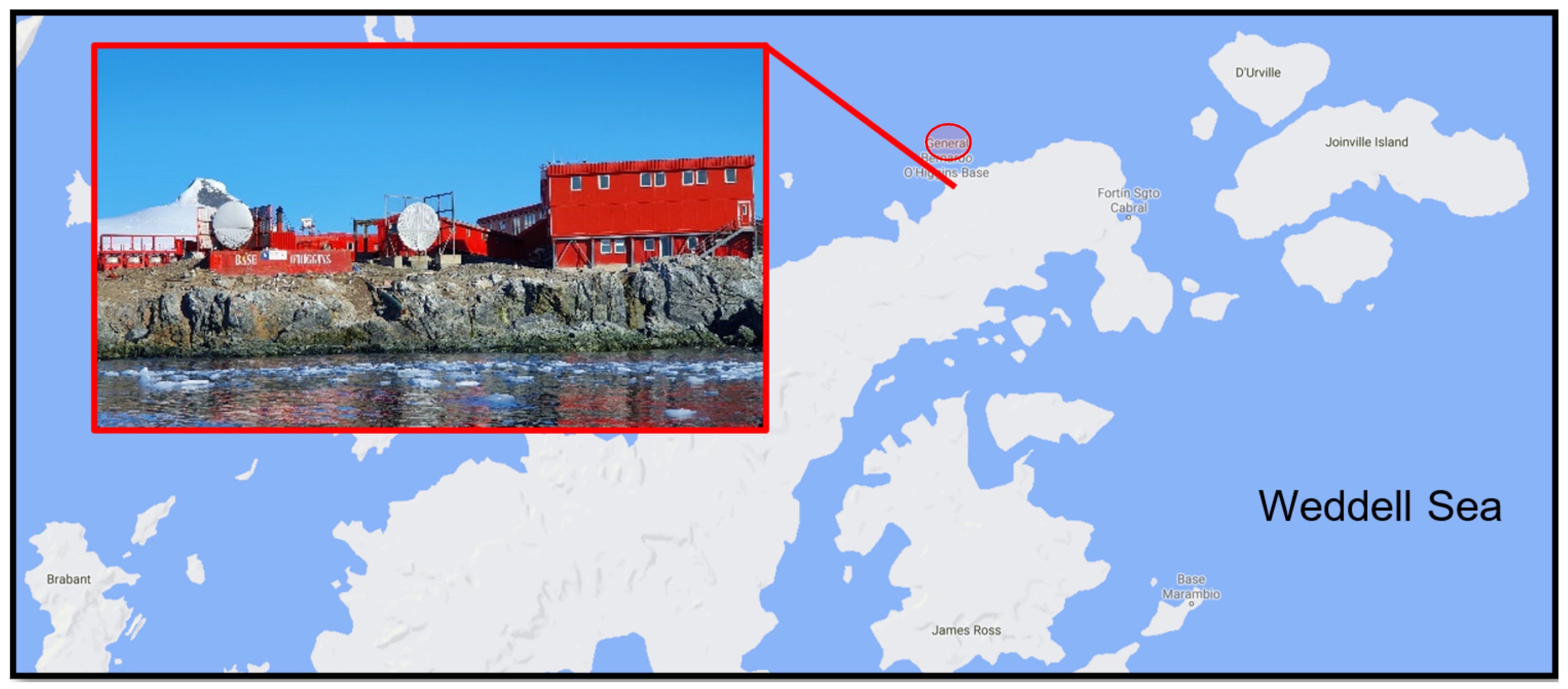
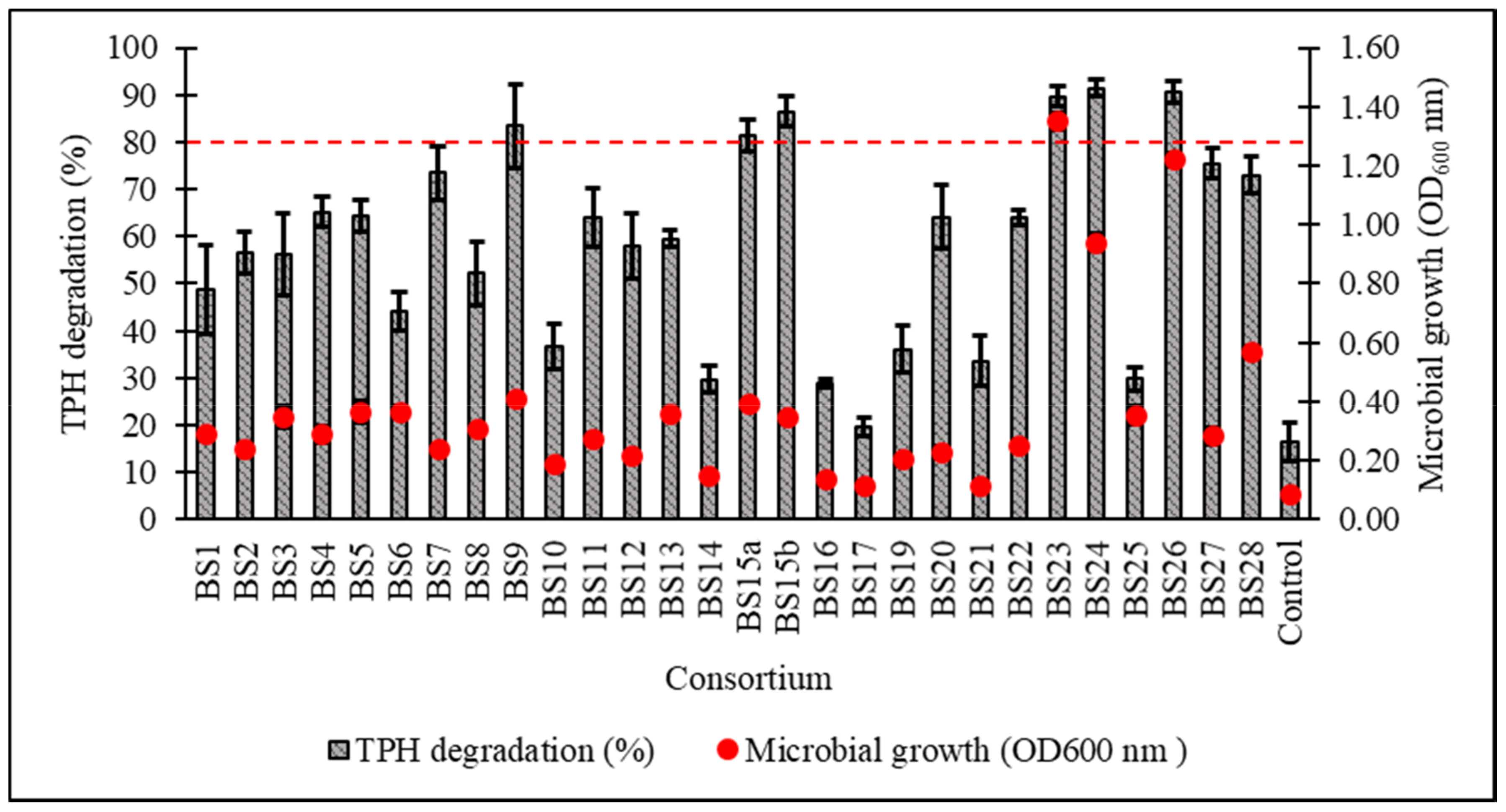
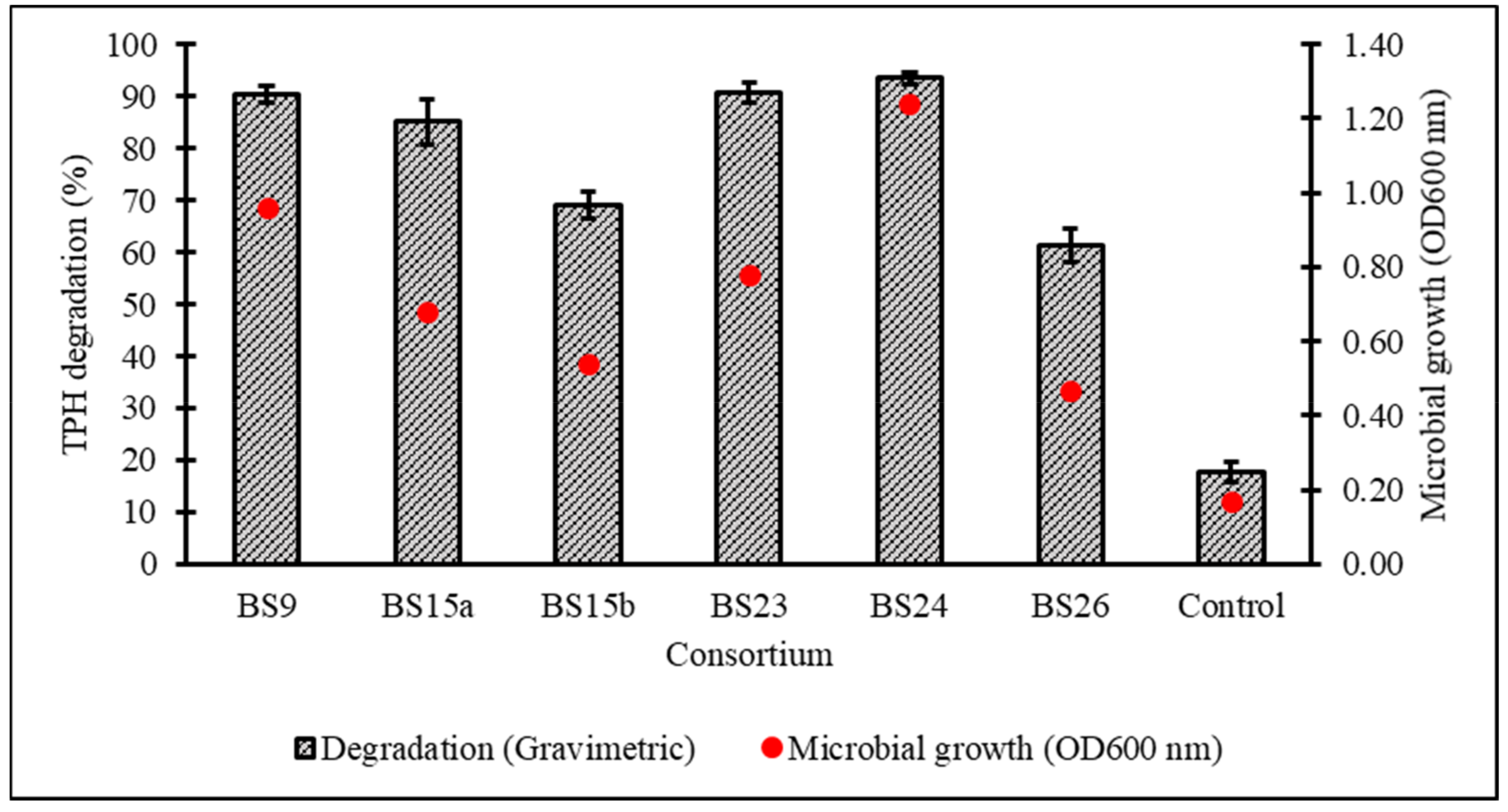
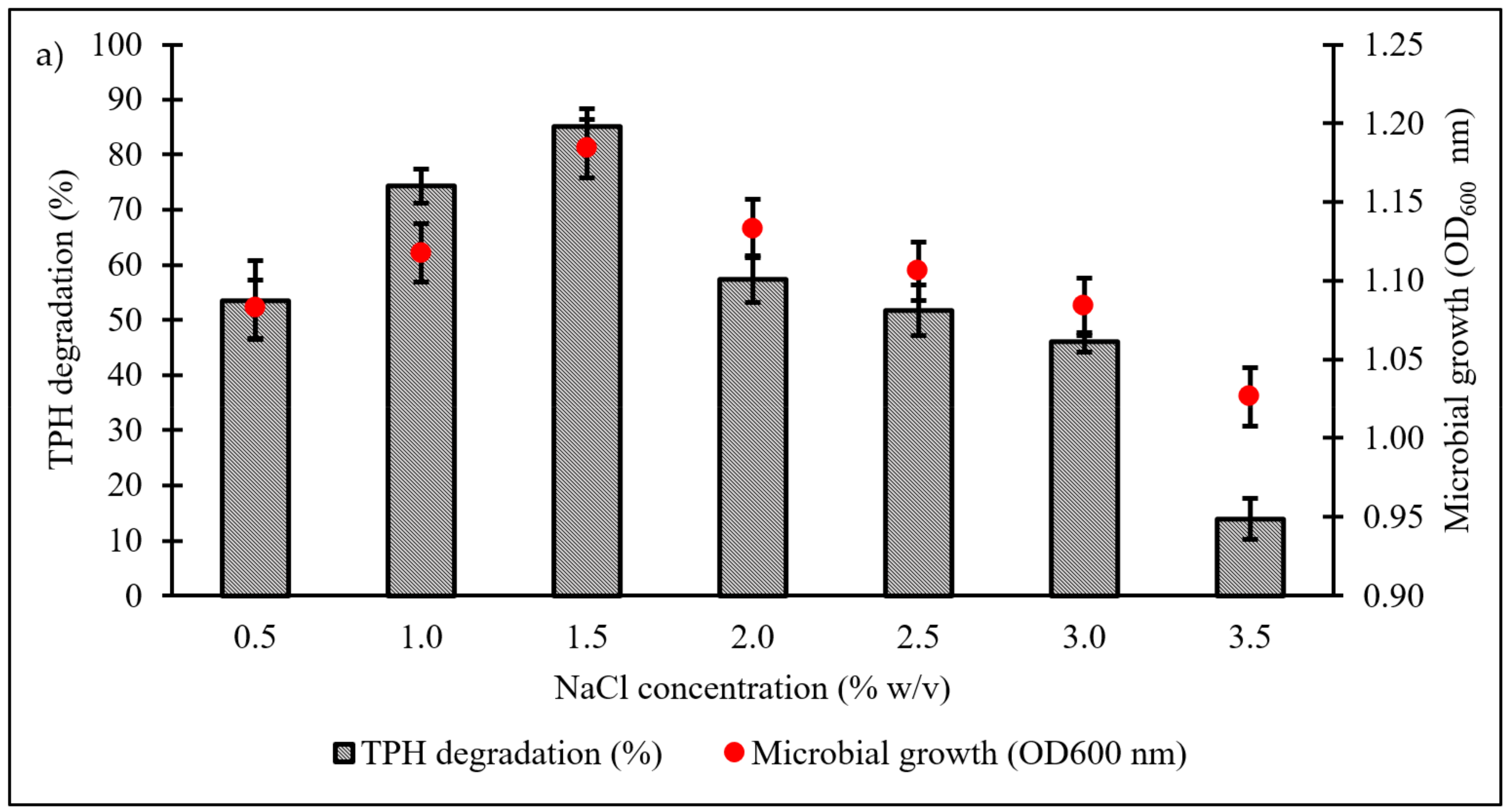
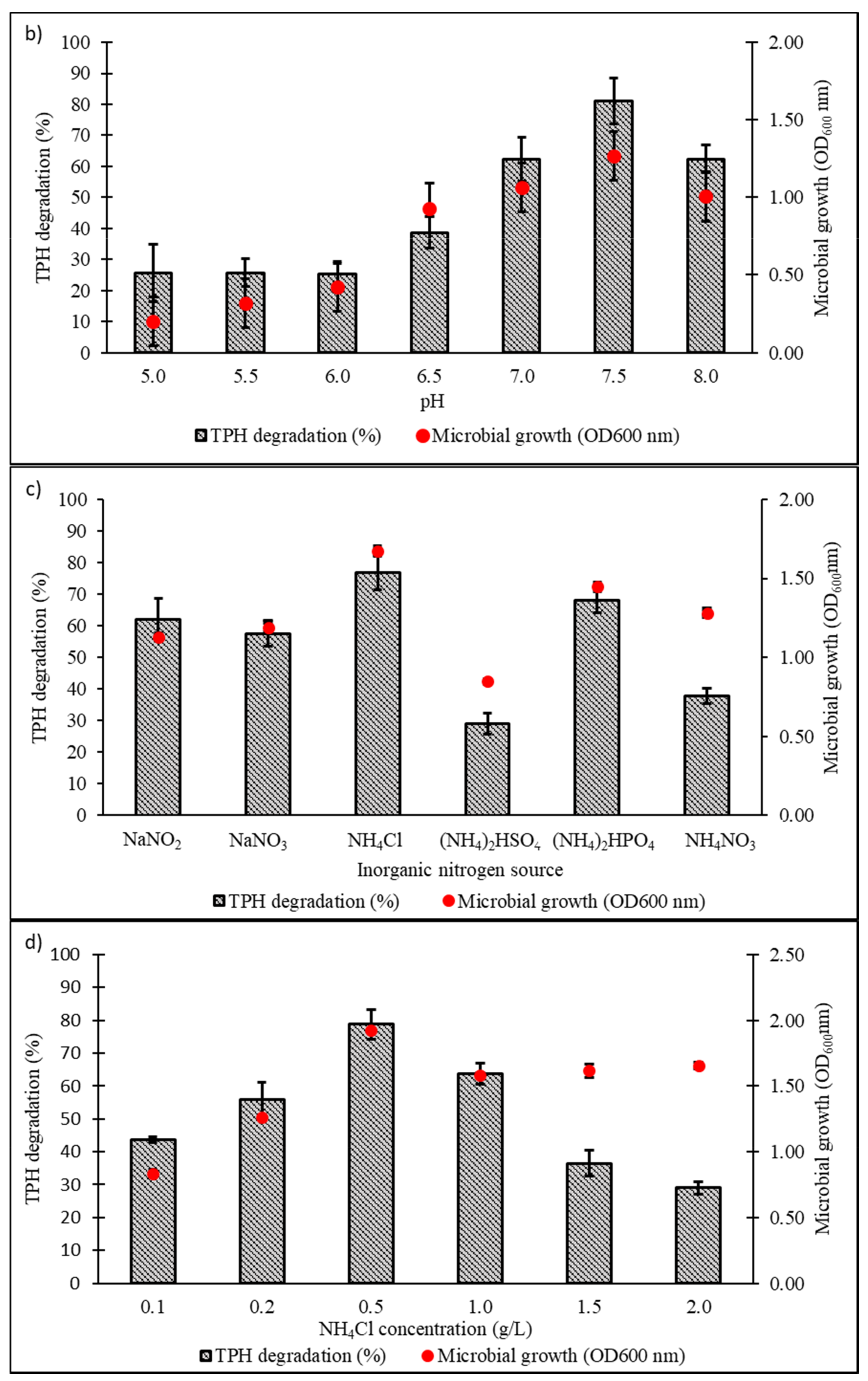
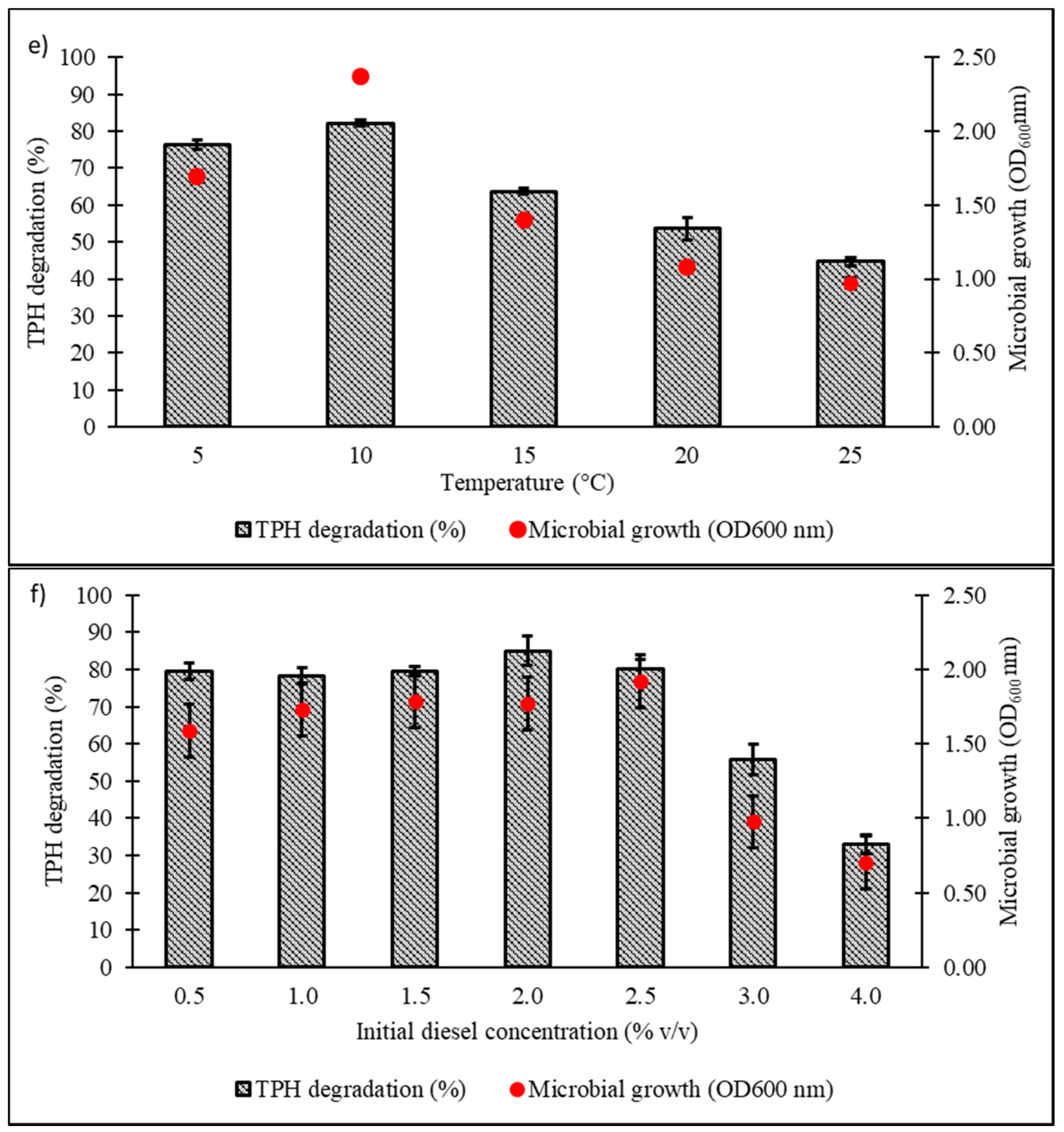
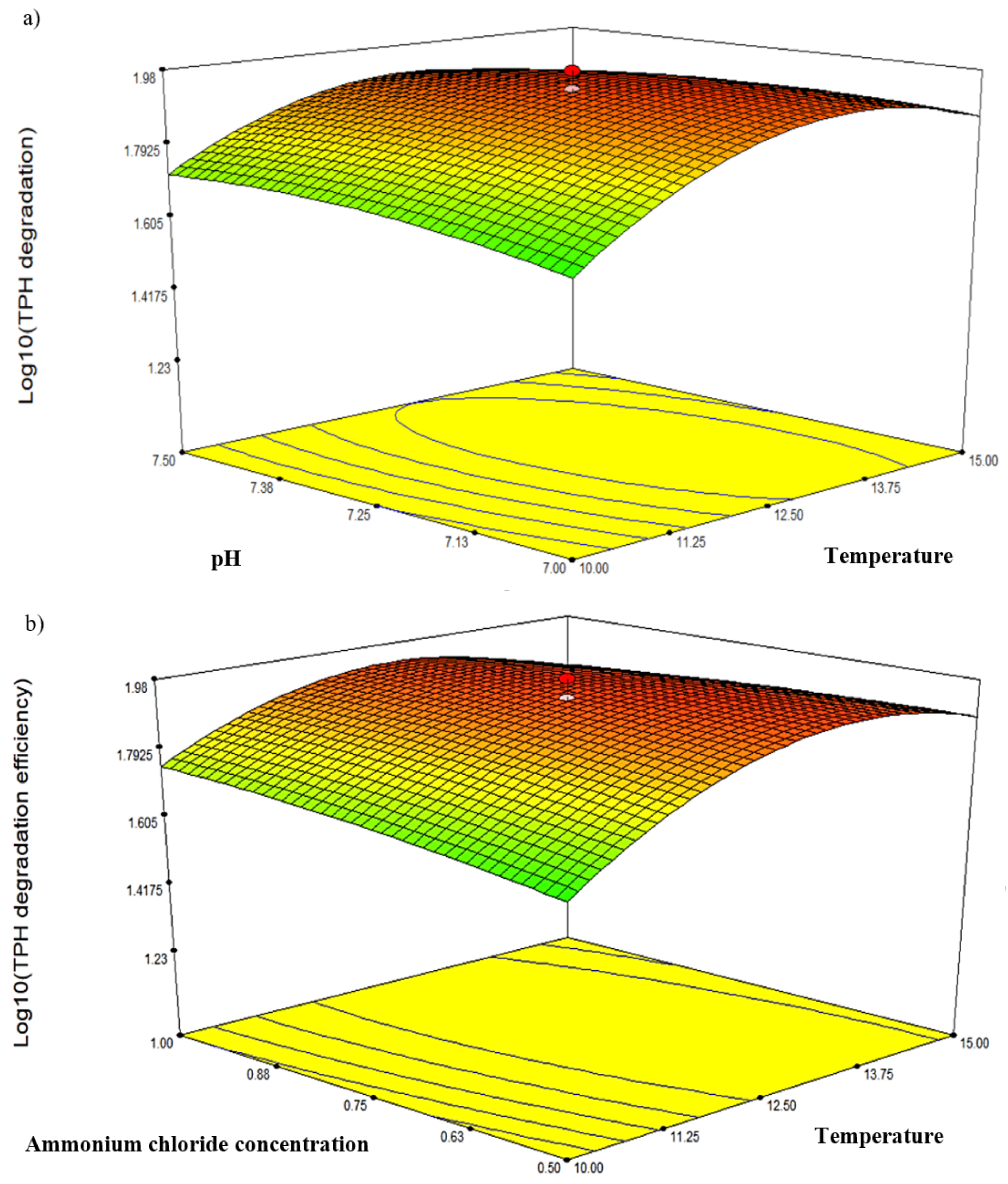
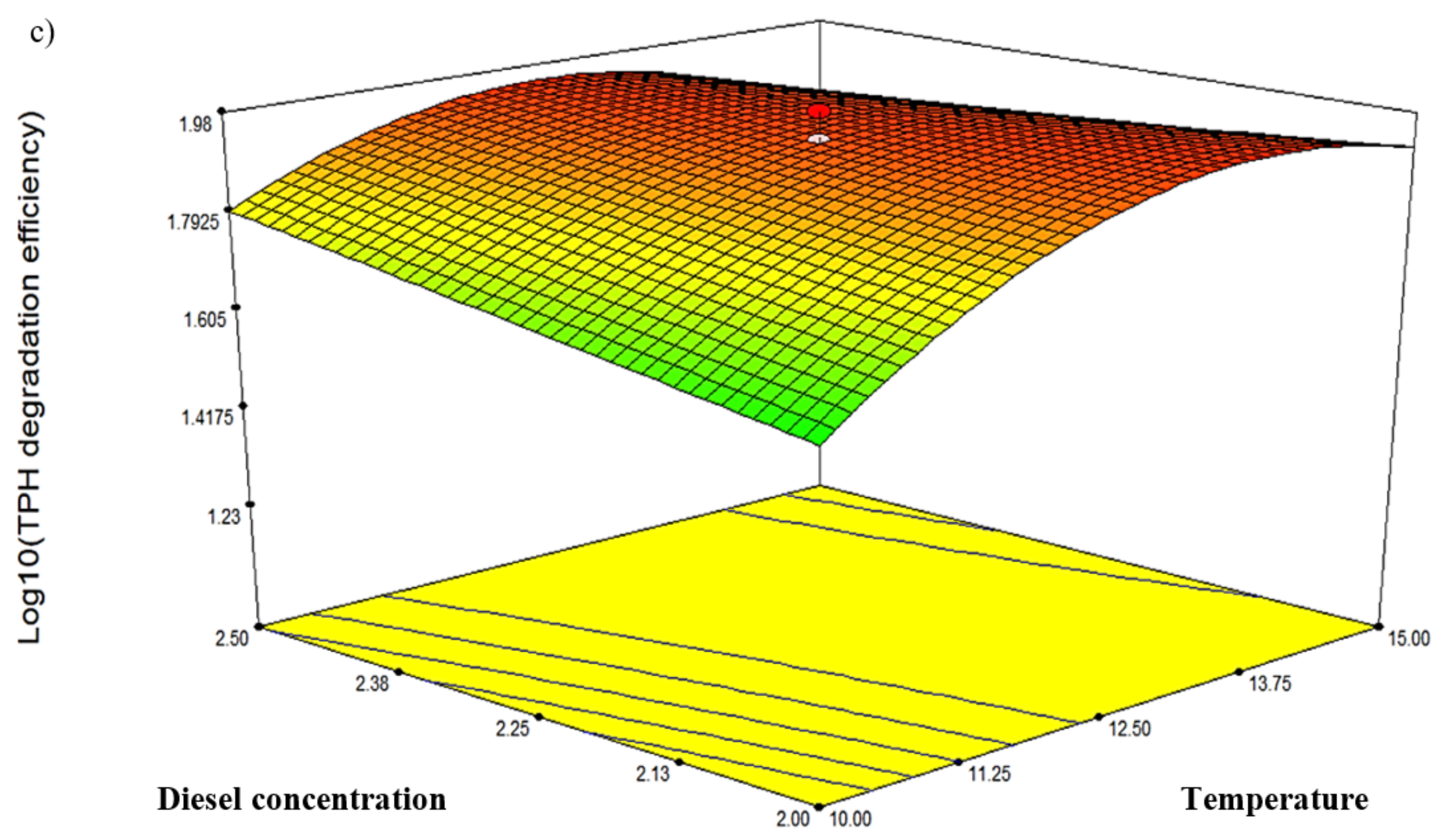
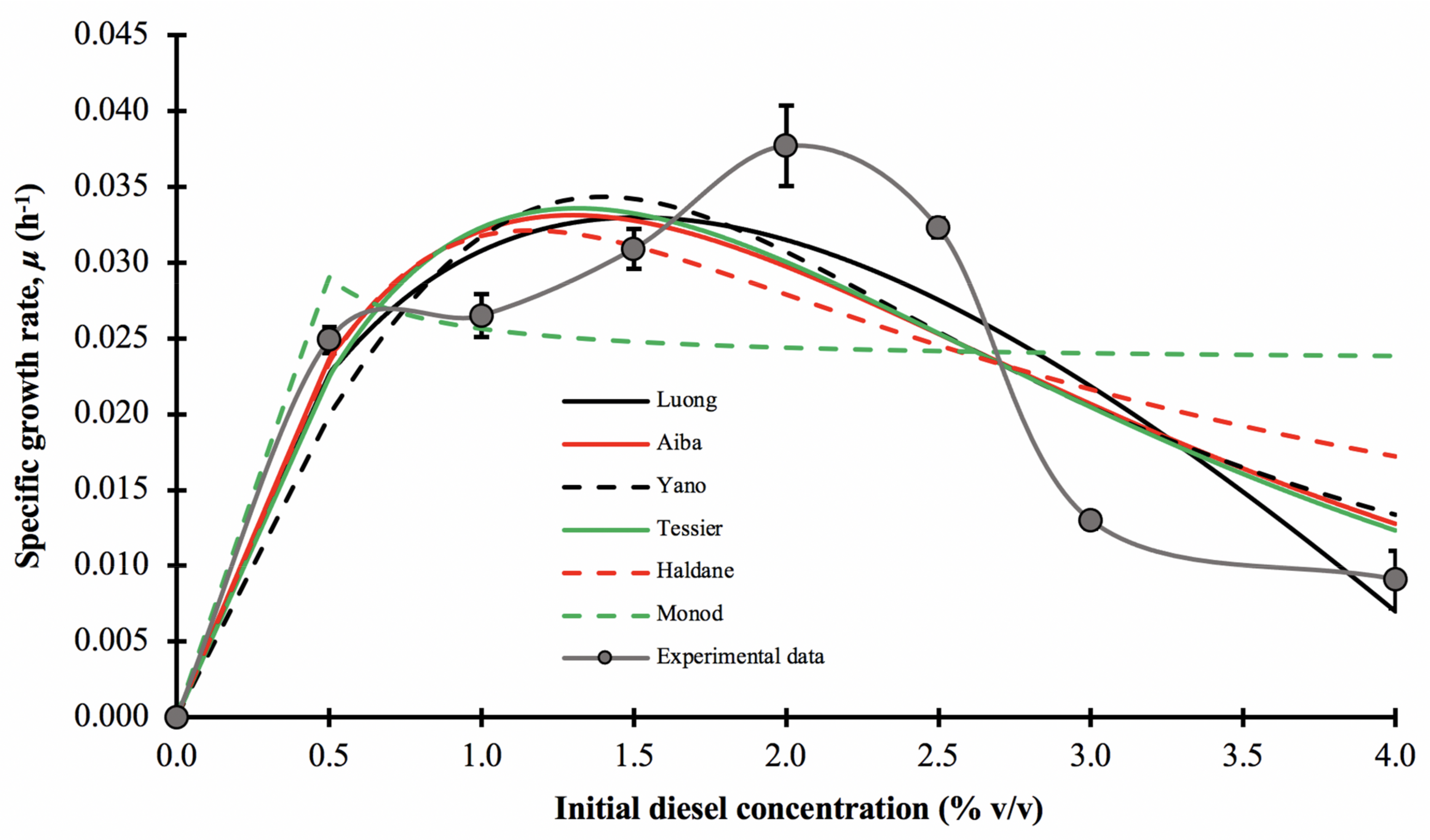
| Actual Factor | Coded Factor | Unit | Low Level (−1) | High Level (+1) |
|---|---|---|---|---|
| pH | A | − | 7.0 a | 7.5 b |
| Temperature | B | °C | 10 c | 15 d |
| Salinity | C | % | 1.0 e | 1.5 f |
| NH4Cl concentration | D | g/L | 0.5 g | 1.0 h |
| Diesel concentration | E | % v/v | 2.0 i | 2.5 j |
| Run | Experimental Value | TPH Degradation (%) | ||||
|---|---|---|---|---|---|---|
| A | B | C | D | E | ||
| 1 | + | + | - | + | + | 34.43 |
| 2 | - | + | + | - | + | 44.44 |
| 3 | + | + | - | + | - | 88.26 |
| 4 | - | + | - | - | - | 52.46 |
| 5 | - | + | + | + | - | 44.75 |
| 6 | + | - | + | + | - | 88.10 |
| 7 | - | - | + | + | + | 55.22 |
| 8 | - | - | - | + | + | 51.28 |
| 9 | - | - | - | - | - | 90.43 |
| 10 | + | - | - | - | + | 58.35 |
| 11 | + | + | + | - | + | 45.76 |
| 12 | + | - | + | - | - | 91.23 |
| Source | Sum of Squares | Df | Mean Square | F Value | p-Value |
|---|---|---|---|---|---|
| Model | 4926.72 | 9 | 492.67 | 294.16 | 0.0453 * |
| A | 115.12 | 1 | 115.12 | 61.18 | 0.0160 * |
| B | 1927.99 | 1 | 1927.99 | 1024.63 | 0.0010 *** |
| C | 12.05 | 1 | 12.05 | 0.57 | 0.5297 |
| D | 81.05 | 1 | 81.05 | 43.07 | 0.0224 * |
| E | 1037.55 | 1 | 1037.55 | 551.40 | 0.0018 ** |
| Residual | 3.76 | 2 | 1.88 | ||
| Cor Total | 4928.39 | 11 | |||
| Std. Dev. | 1.37 | Coeff. Determination, R2 | 0.9992 | ||
| Mean | 62.06 | Adjusted-R2 | 0.9958 | ||
| C.V. % | 2.21 | Predicted-R2 | 0.9889 | ||
| PRESS | 54.53 | Adequate Precision | 46.089 | ||
| Run | Experimental Value | TPH Degradation (%) | |||
|---|---|---|---|---|---|
| A | B | D | E | ||
| 1 | 0 | −2 | 0 | 0 | 17.22 |
| 2 | −1 | −1 | −1 | −1 | 26.14 |
| 3 | +1 | −1 | −1 | −1 | 37.41 |
| 4 | −1 | −1 | +1 | −1 | 37.37 |
| 5 | +1 | −1 | +1 | −1 | 43.83 |
| 6 | −1 | −1 | −1 | +1 | 45.52 |
| 7 | +1 | −1 | −1 | +1 | 51.53 |
| 8 | −1 | −1 | +1 | +1 | 58.08 |
| 9 | +1 | −1 | +1 | +1 | 62.19 |
| 10 | −2 | 0 | 0 | 0 | 68.79 |
| 11 | +2 | 0 | 0 | 0 | 67.53 |
| 12 | 0 | 0 | −2 | 0 | 74.43 |
| 13 | 0 | 0 | +2 | 0 | 81.61 |
| 14 | 0 | 0 | 0 | −2 | 86.10 |
| 15 | 0 | 0 | 0 | +2 | 95.49 |
| 16 | 0 | 0 | 0 | +1 | 94.77 |
| 17 | 0 | 0 | 0 | +1 | 84.36 |
| 18 | 0 | 0 | 0 | +1 | 79.23 |
| 19 | −1 | +1 | −1 | −1 | 80.33 |
| 20 | +1 | +1 | −1 | −1 | 69.05 |
| 21 | −1 | +1 | +1 | −1 | 70.98 |
| 22 | +1 | +1 | +1 | −1 | 63.52 |
| 23 | −1 | +1 | −1 | +1 | 62.58 |
| 24 | +1 | +1 | −1 | +1 | 63.41 |
| 25 | −1 | +1 | +1 | +1 | 58.69 |
| 26 | +1 | +1 | +1 | +1 | 41.77 |
| 27 | 0 | +2 | 0 | 0 | 32.36 |
| Source | Sum of Squares | Df | Mean Square | F Value | p-Value |
|---|---|---|---|---|---|
| Model | 0.81 | 14 | 0.058 | 34.56 | <0.0001 *** |
| A | 5.55 × 10−5 | 1 | 5.55 × 10−5 | 0.033 | 0.8586 |
| B | 0.14 | 1 | 0.14 | 81.37 | <0.0001 *** |
| D | 1.54 × 10−3 | 1 | 1.54 × 10−3 | 0.92 | 0.3546 |
| E | 6.56 × 10−3 | 1 | 6.56 × 10−3 | 3.91 | 0.0664 |
| AB | 0.02 | 1 | 0.02 | 11.88 | 0.0047 ** |
| AD | 0.032 | 1 | 0.032 | 18.83 | 0.1581 |
| AE | 0.08 | 1 | 0.08 | 47.9 | 0.3213 |
| BD | 3.80 × 10−3 | 1 | 3.80 × 10−3 | 2.27 | 0.0001 *** |
| BE | 1.79 × 10−3 | 1 | 1.79 × 10−3 | 1.07 | <0.0001 *** |
| DE | 1.52 × 10−3 | 1 | 1.52 × 10−3 | 0.9 | 0.3605 |
| A2 | 0.022 | 1 | 0.022 | 13.50 | 0.0032 ** |
| B2 | 0.46 | 1 | 0.46 | 279.50 | <0.0001 *** |
| D2 | 6.816 × 10−3 | 1 | 6.816 × 10−3 | 4.10 | 0.0657 |
| E2 | 4.432 × 10−5 | 1 | 4.432 × 10−5 | 0.027 | 0.8730 |
| Residual | 0.02 | 12 | 1.68 × 10−3 | ||
| Lack of Fit | 0.017 | 10 | 1.67 × 10−3 | 0.98 | 0.6042 |
| Pure Error | 3.40 × 10−3 | 2 | 1.70 × 10−3 | ||
| Cor Total | 0.83 | 26 | |||
| Std. Dev. | 0.041 | Coeff. Determination, R2 | 0.9760 | ||
| Mean | 1.76 | Adjusted-R2 | 0.9480 | ||
| C.V. % | 2.32 | Predicted-R2 | 0.8750 | ||
| PRESS | 0.10 | Adequate Precision | 25.282 | ||
| Model | R2 | n | Adj-R2 | RMSE | AICc | Af | Bf |
|---|---|---|---|---|---|---|---|
| Monod [34] | 0.0254 | 2 | −0.1695 | 0.0112 | −62.388421 | 1.000 | 1.000 |
| Aiba [36] | 0.7906 | 3 | 0.7402 | 0.0067 | −65.53920 | 1.002 | 1.002 |
| Tessier [33] | 0.8559 | 3 | 0.7479 | 0.0066 | −65.60998 | 1.002 | 1.002 |
| Haldane [35] | 0.7258 | 3 | 0.6162 | 0.0081 | −62.80734 | 1.002 | 1.002 |
| Yano [38] | 0.8144 | 4 | 0.6564 | 0.0076 | −58.14494 | 1.001 | 1.001 |
| Luong [39] | 0.8145 | 4 | 0.7402 | 0.0066 | −60.31196 | 1.000 | 1.000 |
Publisher’s Note: MDPI stays neutral with regard to jurisdictional claims in published maps and institutional affiliations. |
© 2021 by the authors. Licensee MDPI, Basel, Switzerland. This article is an open access article distributed under the terms and conditions of the Creative Commons Attribution (CC BY) license (https://creativecommons.org/licenses/by/4.0/).
Share and Cite
Roslee, A.F.A.; Gomez-Fuentes, C.; Zakaria, N.N.; Shaharuddin, N.A.; Zulkharnain, A.; Abdul Khalil, K.; Convey, P.; Ahmad, S.A. Growth Optimisation and Kinetic Profiling of Diesel Biodegradation by a Cold-Adapted Microbial Consortium Isolated from Trinity Peninsula, Antarctica. Biology 2021, 10, 493. https://doi.org/10.3390/biology10060493
Roslee AFA, Gomez-Fuentes C, Zakaria NN, Shaharuddin NA, Zulkharnain A, Abdul Khalil K, Convey P, Ahmad SA. Growth Optimisation and Kinetic Profiling of Diesel Biodegradation by a Cold-Adapted Microbial Consortium Isolated from Trinity Peninsula, Antarctica. Biology. 2021; 10(6):493. https://doi.org/10.3390/biology10060493
Chicago/Turabian StyleRoslee, Ahmad Fareez Ahmad, Claudio Gomez-Fuentes, Nur Nadhirah Zakaria, Nor Azmi Shaharuddin, Azham Zulkharnain, Khalilah Abdul Khalil, Peter Convey, and Siti Aqlima Ahmad. 2021. "Growth Optimisation and Kinetic Profiling of Diesel Biodegradation by a Cold-Adapted Microbial Consortium Isolated from Trinity Peninsula, Antarctica" Biology 10, no. 6: 493. https://doi.org/10.3390/biology10060493
APA StyleRoslee, A. F. A., Gomez-Fuentes, C., Zakaria, N. N., Shaharuddin, N. A., Zulkharnain, A., Abdul Khalil, K., Convey, P., & Ahmad, S. A. (2021). Growth Optimisation and Kinetic Profiling of Diesel Biodegradation by a Cold-Adapted Microbial Consortium Isolated from Trinity Peninsula, Antarctica. Biology, 10(6), 493. https://doi.org/10.3390/biology10060493










